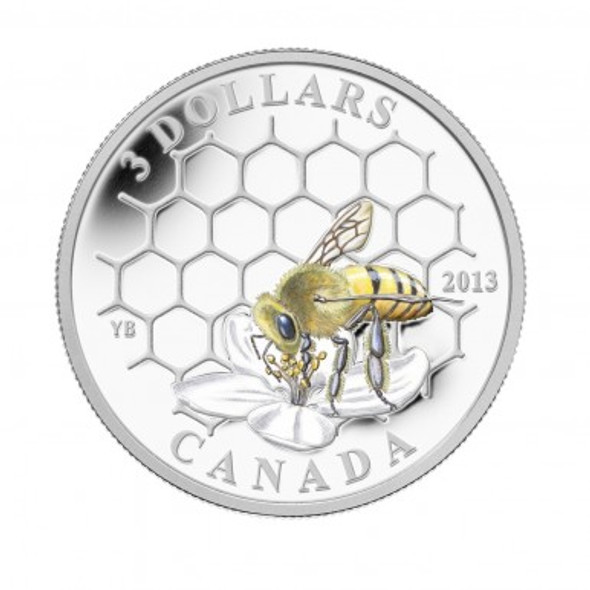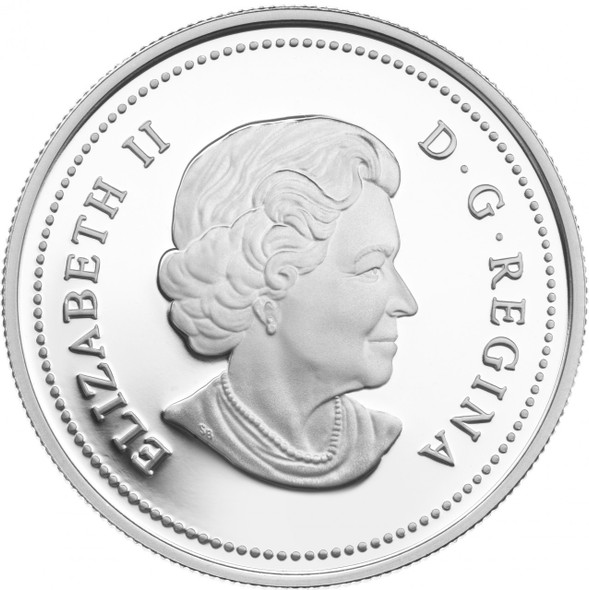Description
Theme:
The second coin in the Royal Canadian Mint’s exciting new series featuring Canada’s animal architects focuses on the orb-weaver spider and its striking web.
Description:
This silver proof coin is certified to be 99.99% proof silver with a diameter of 27 millimetres and a metal weight of 7.96 grams. The reverse design by Canadian artist Yves Bérubé features a painted specimen of an orb-weaver spider sub-species bearing light and dark markings on its back, body, and eight legs. The spider is viewed from the top, poised atop an embossed orb web rendered in fine detail. The image is lent dimensional detail through expert engraving. The spider occupies the upper left quadrant of the web, moving toward the central hub where it will sit in wait for its unsuspecting insect prey. The reverse features the word “CANADA,” the date “2014,” and the face value of “3 DOLLARS.” The obverse features the effigy of Her Majesty Queen Elizabeth II by Susanna Blunt.
Special Features:
- The second coin in the Royal Canadian Mint’s exciting new silver proof series featuring exceptional architects of Canada’s animal world and their unique constructions.
- Mintage is limited to 10,000 coins.
- An excellent gift for nature lovers and an exceptional addition to any collection featuring colour and photo-image designs, Canadian wildlife, or Canadiana.
Product Specifications:
Face Value: 3 dollars
Mintage:10,000
Composition: 99.99% pure silver
Weight (g): 7.96
Diameter (mm): 27
Edge: Serrated
Finish: Proof
Certificate: Serialized
Artist: Yves Bérubé
Packaging:
Coin is encapsulated and presented in a Royal Canadian Mint branded maroon clamshell case lined with flock and protected by a black sleeve.
Advertising Date: October 1, 2013
Launch Date: October 8, 2013
Complete Certificate Text:
Animal Architects
Canada’s vast wilderness is home to thousands of animal species. Among these are the builders—some of nature’s most talented and fascinating creatures. From bird nests to beaver dams, spider webs to anthills, the structures designed and created by these animal architects are models of structural strength and intricacy that have inspired human building in fields such as architecture, medicine, and engineering.
The Astonishing Aerial Architecture of the Orb-Weaver Spider
For thousands of years, in numerous cultures, the spider has been associated with power and mystery, as much for its incredible weaving powers as for its venomous bite. Family Araneidae, representing more than 3006 species of orb-weaving spider globally, is the spider group that spins the circular vertical “orb” webs we see regularly in gardens and forests across Canada and around the world. Each of these wheel-like constructions is a miracle of natural engineering that scientists in many nations are studying for human applications, from web biomechanics to next-generation silk fibres.
Because orb webs are so ubiquitous, it is easy to overlook how astounding they are. The basic scaffolding of an orb web is laid when the spider climbs a vertical surface, such as a tree, and drops a line of silk. This line is incredibly fine, yet is one of the strongest fibres on Earth. The silken thread floats on the wind until it catches on a second nearby vertical surface, such as a branch, to create a tightrope-like horizontal bridge line. The spider then drops another line from the midpoint of the bridge. From this basic frame, the spider strings a non-sticky border and, through a complex series of manoeuvres, creates radius lines—radii—that join the central line to the periphery of the web structure. The spider then weaves its “capture spiral”—a continuous double thread of a specific type of sticky silk that spirals from the outside of the web toward the central hub. At each junction with a radius line, the capture thread is reinforced with a special glue excreted by the spider. The central hub is a non-sticky region where the spider lurks in wait for its prey.
The raw materials of web-building—spider silks—are some of the strongest and most flexible fibres in the world. Their tensile strength exceeds that of steel and Kevlar, yet they are incredibly elastic as well. Created within the spider’s body from semi-crystalline proteins, spider silks begin as liquids and are transformed into filaments by internal application of pressure by the spider as it excretes the silk from individual spigots. Orb-weaver spiders can create up to 8 different types of silks, each originating in its own gland and having its own properties. Producing multiple threads at once, the spider weaves them into a web with its spinnerets—small organs on the underside of its abdomen.
Though researchers have undertaken experiments in extracting spider silk for the purpose of weaving textiles from these fibres, the task is far from efficient. Scientists have yet to successfully replicate this powerful material or the processes required to produce a structure with the exceptional properties of a spider’s web. Thus, the humble spider maintains her place as the queen of weavers, with the orb web in particular one of her most amazing weaving feats.














